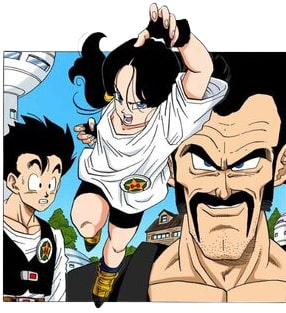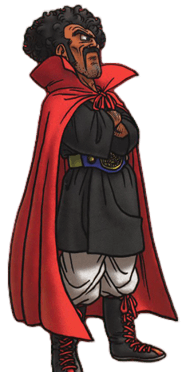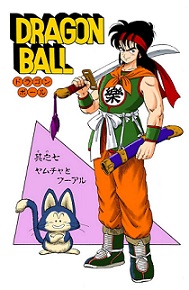
Videl is a fictional character from the Dragon Ball media franchise. Created by Akira Toriyama, she first appears in Chapter 421 of the Dragon Ball manga originally published in Issue 23 of Weekly Shōnen Jump on May 11, 1993. Her name is a play on words with her father's name Mr. Satan. Within the series, she is adept in martial arts like her father and using her abilities to fight crime in the city. She is the love interest of Gohan and plays an important role during the story arc where he is the lead character of Dragon Ball. When Gohan appears as a costumed vigilante known as the Great Saiyaman, she quickly figures out his identity, and blackmails him into teaching her new techniques using her ki. After the main antagonist of the story arc Majin Buu is defeated, the two establish a settled lifestyle and later have a daughter named Pan.

Vegeta, fully referred to as Prince Vegeta IV, is a fictional character in the Japanese franchise Dragon Ball created by Akira Toriyama. Vegeta made his appearance in chapter #204 "Sayonara, Son Goku", published in Weekly Shōnen Jump magazine on January 7, 1989, seeking the wish-granting Dragon Balls to achieve immortality.

Dragon Ball GT is a Japanese anime television series based on Akira Toriyama's Dragon Ball manga that ran from February 1996 to November 1997. Produced by Toei Animation, the series premiered in Japan on Fuji TV and ran for 64 episodes. Unlike Dragon Ball and Dragon Ball Z, the previous two television adaptations in the Dragon Ball media franchise, Dragon Ball GT does not adapt the manga by Toriyama. Dragon Ball GT is an anime-exclusive sequel to Dragon Ball Z with an original storyline using the same characters and universe, which follows the exploits of Son Goku, the series protagonist who is turned into a child; his granddaughter, Pan; and their associates on a quest to collect Black Star Dragon Balls, a set of Dragon Balls which are hidden throughout the universe.

Tien Shinhan, known as Tenshinhan in the Japanese media and Viz Media's release of the manga, is a fictional character in the Dragon Ball franchise created by Akira Toriyama. He made his appearance in chapter #113 "The 22nd Tenkaichi Budōkai", first published in Weekly Shōnen Jump magazine on February 24, 1987, entering the World Martial Arts Tournament to defeat Son Goku and his fellow-students. However, he later teams up with them to defeat King Piccolo, accompanied by his best friend Chiaotzu. Tien becomes Goku's rival for a period and is notable for being the first person in the series to fly using Bukū-jutsu and to use the Taiyōken technique.

Mr. Satan, known as Hercule in certain edited versions of the English dub and in Viz's English manga, is a character from the Dragon Ball media franchise. Created by Akira Toriyama, he first appears in Chapter 393 of the Dragon Ball manga entitled "The New Kami-sama", originally published in Issue 44 of Weekly Shōnen Jump on October 6, 1992. Within the series, he is a flamboyant martial artist who becomes a world-renowned hero after he fallaciously claimed credit for the defeat of the villainous Cell. Years later, he befriends the primordial being Majin Buu and convinces him of the error of his murderous way, leading Buu to expel his evil tendencies which become a different lifeform altogether. After aiding series protagonist Goku in vanquishing the evil incarnation of Buu, the benevolent incarnation moves in with Mr. Satan, and both characters continue to make recurring appearances as supporting characters in the series.

Yamcha is a fictional character in the Dragon Ball manga series created by Akira Toriyama. He is first introduced as a desert bandit and an antagonist of Son Goku in chapter #7 "Yamcha and Pu'ar", published in Weekly Shōnen Jump magazine on September 11, 1984, alongside his constant companion Pu'ar. He is eventually depicted as being reformed, becoming an ally of Goku. He was initially portrayed as gynophobic, although this characteristic has fluctuated or subsided throughout the original Dragon Ball series.

Son Goku is a fictional character and the main protagonist of the Dragon Ball manga series created by Akira Toriyama. He is based on Sun Wukong, a main character of the classic 16th-century Chinese novel Journey to the West, combined with influences from the Hong Kong action cinema of Jackie Chan and Bruce Lee. Goku made his debut in the first Dragon Ball chapter, Bulma and Son Goku, originally published in Japan's Weekly Shōnen Jump magazine on December 3, 1984. Goku is introduced as an eccentric, monkey-tailed boy who practices martial arts and possesses superhuman strength. He meets Bulma and joins her on a journey to find the seven wish-granting Dragon Balls. Along the way, he finds new friends who follow him on his journey to become stronger. As Goku grows up, he becomes the Earth's mightiest warrior and battles a wide variety of villains with the help of his friends and family, while also gaining new allies in the process.

Toei Animation Co., Ltd. is a Japanese animation studio primarily controlled by its namesake Toei Company. It has produced numerous series, including Sally the Witch, GeGeGe no Kitarō, Mazinger Z, Galaxy Express 999, Cutie Honey, Dr. Slump, Dragon Ball, Saint Seiya, Sailor Moon, Slam Dunk, Digimon, One Piece, Toriko, World Trigger, The Transformers, and the Pretty Cure series.
Chi-Chi, sometimes written as Chi Chi, is a fictional character from the Dragon Ball media franchise. Created by Akira Toriyama, she first appears in Chapter #11 of the Dragon Ball manga entitled "...And into the Fire!". Typically portrayed as the shrewish and fiery wife of series protagonist Son Goku and the overprotective mother of Son Gohan and Son Goten, Chi-Chi is considered to be one of the most prominent female characters in the franchise, and is featured consistently in merchandise and in cosplay by the Dragon Ball fandom.

Dragon Ball Z Trading Card Game is an out-of-print trading card game based on the Dragon Ball series created by Akira Toriyama. The game was produced by Score Entertainment and uses screen captures of the anime to attempt to recreate the famous events and battles seen in the anime. Score then sold the rights to Panini which eventually ceased publishing.
An abridgement is a condensing or reduction of a book or other creative work into a shorter form while maintaining the unity of the source. The abridgement can be true to the original work in terms of mood and tone, capturing the parts the abridging author perceives to be most important; it could be a complete parody of the original or it could fall anywhere in between, generally capturing the tone and message of the original author but falling short in some manner or subtly twisting their words and message to favor a different interpretation or agenda.
Dragon Ball is a Japanese media franchise created by Akira Toriyama in 1984. The initial manga, written and illustrated by Toriyama, was serialized in Weekly Shōnen Jump from 1984 to 1995, with the 519 individual chapters collected in 42 tankōbon volumes by its publisher Shueisha. Dragon Ball was originally inspired by the classical 16th-century Chinese novel Journey to the West, combined with elements of Hong Kong martial arts films. Dragon Ball characters also use a variety of East Asian martial arts styles, including karate and Wing Chun. The series follows the adventures of protagonist Son Goku from his childhood through adulthood as he trains in martial arts. He spends his childhood far from civilization until he meets a teen girl named Bulma, who encourages him to join her quest in exploring the world in search of the seven orbs known as the Dragon Balls, which summon a wish-granting dragon when gathered. Along his journey, Goku makes several other friends, becomes a family man, discovers his alien heritage, and battles a wide variety of villains, many of whom also seek the Dragon Balls.

Bulma is a fictional character in the Dragon Ball franchise, first appearing in the original manga series created by Akira Toriyama. She made her appearance in the first chapter "Bulma and Son Goku", published in Weekly Shōnen Jump magazine on June 19, 1984, issue 51, meeting Goku and befriending him and traveling together to find the wish-granting Dragon Balls.

Majin Buu, generally spelled Majin Boo in subtitles of the Japanese anime, and rendered as Djinn-Boo in the Viz Media manga, is a fictional character and final antagonist in the Dragon Ball manga series created by Akira Toriyama, before the release of Dragon Ball Super. He made his debut appearance in chapter #460 "Majin Buu Appears?!", first published in Weekly Shōnen Jump magazine on March 1, 1994. Majin Buu is a genie-like magical life form awoken by the evil warlock Bibidi that terrorized the universe millions of years before the events of Dragon Ball take place.
Dragon Ball Z is a Japanese anime television series produced by Toei Animation. Part of the Dragon Ball media franchise, it is the sequel to the 1986 Dragon Ball television series and adapts the latter 325 chapters of the original Dragon Ball manga series created by Akira Toriyama. The series aired in Japan on Fuji TV from April 1989 to January 1996 and was later dubbed for broadcast in at least 81 countries worldwide.

Dragon Ball Z: Resurrection 'F' is a 2015 Japanese animated science fantasy martial arts film and the sequel to Dragon Ball Z: Battle of Gods (2013). It is the nineteenth animated feature film based on the 1984–95 manga series Dragon Ball, the fifteenth to carry the Dragon Ball Z branding, and is the second film in the franchise to be personally supervised by series creator Akira Toriyama. The film's plot depicts the return of Frieza, who after his resurrection via the eponymous Dragon Balls, goes into extensive training with the purpose to enact his revenge against Goku.

Dragon Ball Z: Kakarot is an action role-playing game developed by CyberConnect2 and published by Bandai Namco Entertainment, based on the Dragon Ball franchise. It was released for PlayStation 4, Xbox One and Windows in January 2020, Nintendo Switch in September 2021, Stadia in October 2021, PlayStation 5 in January 2023, and Xbox Series X/S in February 2023. The game follows the main protagonist Goku and the Z-Fighters throughout the events of the Dragon Ball Z anime, including anime-original storylines and moments.

Dragon Ball Z: Hyper Dimension is a 1996 fighting video game developed by Tose and published by Bandai for the Super Nintendo Entertainment System. Based upon Akira Toriyama's Dragon Ball franchise, it is the last fighting game in the series to be released for SNES. Following from the Frieza saga to the conclusion of the Majin Buu saga, its gameplay is similar to the earlier Butōden entries, consisting of one-on-one fights using a main six-button configuration, featuring special moves as well as multiple game modes.














